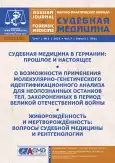Questions of forensic science and radiology on live births and stillbirths: cases from expert practice
- Authors: Klevno V.A.1, Chumakova Y.V.1,2, Dubrova S.E.1, Muranova N.S.2, Popova O.M.2
-
Affiliations:
- Moscow Regional Research and Clinical Institute
- Forensic Medical Examination Bureau
- Issue: Vol 7, No 2 (2021)
- Pages: 101-107
- Section: Case reports
- URL: https://journals.rcsi.science/2411-8729/article/view/122417
- DOI: https://doi.org/10.17816/fm364
- ID: 122417
Cite item
Full Text
Abstract
Background: The article discusses the criteria, forensic and radiological “life tests,” difficulties in assessing the results of live births and stillbirths. It also dives into the history of the development of X-ray, including pre-sectional examination of newborn corpses. Two cases of newborn corpses that were subjected to pre-sectional computed tomography (CT) are presented. Case presentation: Case no. 1: Examination of a newborn corpse found in a cardboard box on the unheated terrace of a private house after a secret self-birth. Case no. 2: Examination of the corpse of an infant with massive injuries and the division of the body into two fragments, found on a sorting tape in the premises of a waste sorting shop. Conclusion: Postmortem CT of newborn corpses was an evidence-based and visual addition to the traditional forensic medical study. This helped determine the maturity of fetuses even at the pre-dissection stage to identify injuries and anatomical variants of the structure, to refute the presence of congenital deformities, and to establish and record evidence-based CT signs of live birth and stillbirth.
Full Text
##article.viewOnOriginalSite##About the authors
Vladimir A. Klevno
Moscow Regional Research and Clinical Institute
Email: vladimir.klevno@yandex.ru
ORCID iD: 0000-0001-5693-4054
SPIN-code: 2015-6548
Dr. Sci. (Med.), Professor
Russian Federation, 61/2, Shepkina street, Moscow, 129110Yulia V. Chumakova
Moscow Regional Research and Clinical Institute; Forensic Medical Examination Bureau
Author for correspondence.
Email: chumakova@sudmedmo.ru
ORCID iD: 0000-0002-9738-8288
SPIN-code: 9415-3226
MD, Research Postgraduate, Department of Forensic Medicine
Russian Federation, 61/2, Shepkina street, Moscow, 129110; MoscowSofia E. Dubrova
Moscow Regional Research and Clinical Institute
Email: dubrova.sofya@gmail.com
ORCID iD: 0000-0001-8809-1629
SPIN-code: 5012-9847
MD, PhD, Research Postgraduate, Department of Forensic Medicine
Russian Federation, 61/2, Shepkina street, Moscow, 129110Natalia S. Muranova
Forensic Medical Examination Bureau
Email: muranova@sudmedmo.ru
MD
Russian Federation, MoscowOlga M. Popova
Forensic Medical Examination Bureau
Email: vodyasova@sudmedmo.ru
MD
Russian Federation, MoscowReferences
- Kolkutin VV, Kira EF, Barinov EKh., et al. Examination of fetal and newborn corpses: Methodological recommendations. Moscow: Russian Center of Forensic Medical Expertise; 2002. (In Russ).
- Chopеn IV, Bezborodov AV, Tishchenko OV. Forensic medical examination of fetuses and newborns. Educational and methodological recommendations for students of the Faculty of Pediatrics, interns, residents. Stavropol: Stavropol State Medical University; 2010. 44 p. (In Russ).
- You will be healthy — you will get everything [internet resource]. X-ray examination in forensic medical practice. (In Russ). Available from: https://ja-zdorov.at.ua/publ/rentgenologicheskoe_issledovanie_novorozhdennykh/rentgenologicheskoe_issledovanie_v_sudebno_medicinskoj_praktike/79-1-0-1042
- Rukont: national digital resource. Tumanova, Shchegolev AI. Postmortem magnetic resonance imaging of fetuses and newborns. Medical visualization. 2015. N. 5. Р. 127–135. (In Russ). Available from: https://rucont.ru/efd/502572
- Tumanova UN, Fedoseeva VK, Lyapin VM, et al. Identification of gas accumulations in the bodies of fetuses, still-borns and dead newborns at postmortem computed tomography study. Consilium Medicum. 2016;18(13):26–33. (In Russ).
- Rusakova TV, Kislov MA, Lysenko OV, Dubrova SE. Virtual autopsy as valuable assistance in building the algorithm of study the children corpses. Russian Journal of Forensic Medicine. 2019;5(1s):57. (In Russ).
- Klevno VA, Chumakova YuV. Virtopsia — a new research method in the practice of domestic forensic medicine. Russian Journal of Forensic Medicine. 2019;5(2):27–31. (In Russ). doi: 10.19048/2411-8729-2019-5-2-27-31
- Klevno VA, Chumakova YuV, Korotenko OA, et al. Virtopsia in the case of sudden death of a teenager. Russian Journal of Forensic Medicine. 2020;6(1):41–45. (In Russ). doi: 10.19048/2411-8729-2020-6-1-41-45
Supplementary files

















